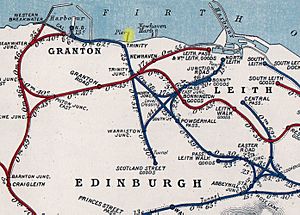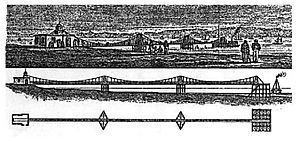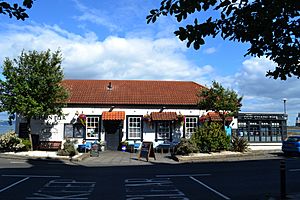Trinity Chain Pier facts for kids
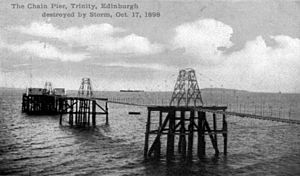
The pier
|
|
| Type | Ferry pier |
|---|---|
| Carries | Passengers |
| Spans | Firth of Forth |
| Locale | Edinburgh, Scotland |
| Design | Samuel Brown |
| Owner | Trinity Pier Company |
| Total length | 700 feet (210 m) |
| Width | 4 feet (1.2 m) |
| Opening date | 14 August 1821 |
| Destruction date | 18 October 1898 |
| Coordinates | 55°58′49″N 3°12′16″W / 55.980192°N 3.204438°W |
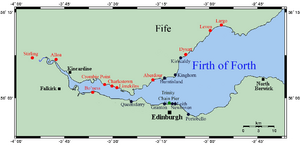
Map of the Firth of Forth showing (in red) some of the destinations served from the pier in its heyday
|
|
The Trinity Chain Pier was a special pier built in 1821 in Trinity, Edinburgh, Scotland. It was first called the Trinity Pier of Suspension. This pier was designed by Samuel Brown, who was a clever inventor of chains and suspension bridges.
The pier was built to help ferry boats carry people across the Firth of Forth. This was a time when new technologies were changing travel. For about 20 years, many people used the pier for ferries. But then, new ports opened nearby, and the pier became more popular for sea bathing (swimming in the sea). A big storm destroyed the pier in 1898. Today, a building that was once part of the pier still stands. It has been rebuilt and is now a pub and restaurant called the Old Chain Pier.
Contents
Why Was the Pier Built?
The Firth of Forth is a wide river mouth that separates Edinburgh, Scotland's capital, from the peninsula of Fife. For hundreds of years, crossing the firth was very important. Fife had farms and factories, and it was the shortest way from Edinburgh to the north of Scotland. For a long time, the closest bridge to Edinburgh was at Stirling, about 36 miles (58 km) to the west.
Travel by sailing boat and stagecoach was slow and often unreliable. The late 1700s and early 1800s brought big changes in how people traveled. New roads were built, and canals helped move goods. Then came the steamboat, which made sea travel much faster and more predictable.
The Trinity Chain Pier was built because the new steam-powered boats caused too much traffic at the older ports of Leith and Newhaven. Also, sandbars (shallow areas) made it hard for boats to get in and out of those harbors at low tide. It was easier to build a new pier than to make more space at Newhaven.
How Was the Pier Designed?
Lieutenant George Crichton first suggested building the pier. In 1820, the city leaders of Edinburgh gave permission for it. The Trinity Pier Company then hired Captain Samuel Brown to design it. This was Brown's first big project on his own. It cost about £4,000 to build.
Brown (1776–1852) was a navy officer who fought in wars. He invented a way to build suspension bridges in 1817. He designed the Union Bridge in 1820, which was the biggest suspension bridge in the world at the time. It was also the first in Britain to carry vehicles.
Brown had experimented with using strong chains instead of ropes on ships. He thought that using piles (long poles driven into the ground) to support a pier was better than building with stone. It was cheaper and made it easier for ships to dock. Brown used chains in his bridge designs. He found that chains made of eye bolts joined together were stronger than older designs. He was known as a "leading promoter" of suspension bridges.
The pier was 700 feet (213 meters) long and had a narrow passenger deck, about 4 feet (1.2 meters) wide. This deck was made of three wooden sections. They hung about 10 feet (3 meters) above high water from strong wrought-iron chains. These chains connected to tall cast-iron arches on the shore. Passengers walked through these arches.
The chains were made of eye bolts, each about 10 feet (3 meters) long. These bolts were different thicknesses depending on how much weight they needed to hold. The pier was only for people walking on it. It would even move a little when people walked across it!
In 1821, Brown tested the pier by putting 21 tons of heavy metal on it while people were using it. The pier was also made stronger in 1822 after some storms.
History of the Pier
Ferry Services
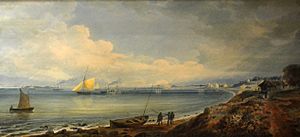
Bad weather delayed building the pier, but it finally opened on August 14, 1821. Flags decorated the pier, and steamboats fired salutes. Many important people attended the opening, including the Lord Provost of Edinburgh and the pier's designers.
The pier was very useful because it could be used at all tides. The older ports of Leith and Newhaven often had problems with shallow water at low tide. But the Chain Pier always had enough water for boats. In its first year, the pier made a good profit. People called it "ingenious and beautiful."
In 1822, King George IV was visiting Edinburgh. People thought about using the pier for his arrival, but he landed at Leith instead. The "New Cut" road was built for his parade from the pier.
For a few years, other ferry companies tried to stop boats from the Chain Pier from landing at certain ports in Fife. But by 1829, ferries from the Chain Pier were allowed to go to more places.
In 1823, tiny sea creatures called 'gribble worms' started to damage the wooden piles that supported the pier. These worms bored holes in the wood. After many tries to fix them, the piles had to be replaced in 1830. This was a difficult and dangerous job. The cost of these repairs put the company into debt.
In the 1830s, many people used the ferries. For example, one boat carried over 8,000 passengers in two months. Ferries went to places like Dysart, Leven, and Largo. You could even get a stagecoach from Largo to other towns.
In 1832, the French King Charles X, who was living in exile, used the pier to leave Scotland. In 1833, a ferry called the Benlomond caught fire just after leaving the pier. Luckily, other boats rescued all 220 passengers before it sank.
In 1834, a clock and a large bell were put at the pier's entrance. The bell rang before each steamer left to help prevent delays. By 1842, you could travel from Trinity to many towns, including Stirling and Dundee.
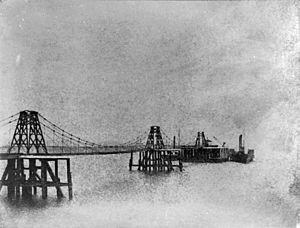
An artist named Alexander Nasmyth painted the pier in a watercolour painting. This painting is now in the Scottish National Gallery. In 1840, a very early photograph (called a calotype) of the pier was taken. This photo was part of a collection found in 2002 and bought by the National Library of Scotland.
By 1835, about 400,000 people used Newhaven harbor and the Chain Pier each year. However, fewer ferries started using the Chain Pier as Leith and Newhaven improved their own harbors. In 1838, a new, large harbor opened at Granton, which made Chain Pier traffic drop even more.
Sea Bathing and Decline
In the early 1800s, swimming in the sea became very popular in Britain. People thought it was good for their health. In 1840, a company bought the pier and rented it out. They added changing rooms for swimmers. By 1842, the pier was mostly used by people who wanted to swim.
In the 1840s, railways made travel much faster. From 1842, a railway line connected the pier to Edinburgh. This made it easier for people to get to the pier for ferries and swimming.
By the 1850s, the pier was starting to fall apart, but it was still popular with swimmers. Early morning trains were advertised so people could swim before work. There was even a gym at the end of the pier. The Forth Swimming Club started there in 1850. They held swimming competitions, including races and underwater contests.
In 1859, a new company bought the pier. It became old and needed expensive repairs to stay open. Some local people were worried that opening the pier for swimming on Sundays would stop people from going to church.
By 1869, you could take omnibuses (horse-drawn buses) from Edinburgh to the Chain Pier. The popularity of sea bathing started to decline as the water became more polluted with sewage and factory waste. People started to prefer indoor swimming pools.
The pier was badly damaged on October 18, 1898, by a huge storm. The storm lasted four days and caused a lot of destruction across Scotland. The storm completely removed the pier's deck and chains. It also destroyed the platform closest to the shore. The pier was never repaired, and the sea slowly eroded its remains. You can still see some parts of the wooden piles at low tide.
The Old Chain Pier Pub
The public house at the shore end of the pier was called the Pier Bar in 1878. It was badly damaged by a fire in March 1898. But it survived the pier's destruction later that year. It then became known as the Old Chain Pier.
The pub has been rebuilt and changed over the years. In 1998, a conservatory was added. In 2001, it was named Edinburgh's pub of the year (jointly with another pub).
The Old Chain Pier was rebuilt again after a big fire in 2004. It is the only building on the north side of Trinity Crescent. Part of the pub even sticks out over the sea! It was updated in 2011 and now works as both a pub and a restaurant. It is known for its seafood and welcomes children in its conservatory area.


